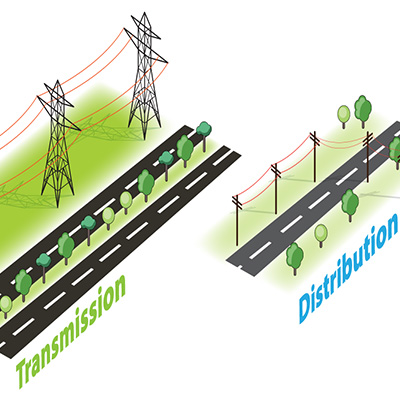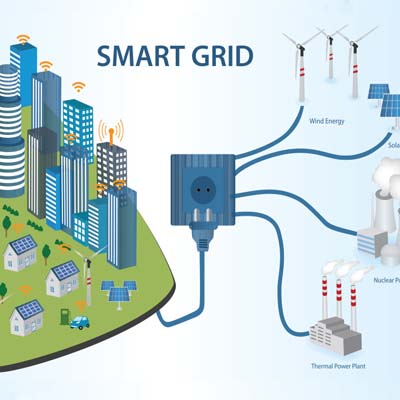Published On: May 25, 2015
In India, where the electricity demand is escalating and with its year-on-year growth rate (i.e. demand-supply gap of ~5.1% as of 2014), there is a need to add capacity in the system generation. Almost, all integrated power systems in India and world have been relying on centralized electricity generation such as large-scale hydro, coal, natural gas and nuclear power plants. Electricity is then distributed along long-distance with high voltage lines from centralized sources to the customers’ premise. However, the existing scenario is changing with the demand for clean, reliable and affordable electricity generation. These requirements are posing challenges to traditional methods of delivering electricity and hence the evolution of Distributed Generation has seen a huge potential.
The term Distributed Generation (DG) refers to electric power generation technology that is integrated within distribution systems, close to the point of use. Distributed generators are usually connected to medium or low voltage grid (generally until 33kV). They are not centrally planned and are typically smaller than 30 MW capacity. These systems have small and micro-generators connected directly to end users like factories, offices and households. Also, excess electricity generated by the directly connected consumers is fed into the active distribution network to meet demand elsewhere.
Considering the above scenario, tomorrow’s grid will be dominated by distributed generation – prime mover being sustainable energy for addressing climate change. The reasons for this change are numerous and debatable, but include such factors as environmental concerns, increase in cost to traditional energy sources and at the same time reductions in cost to new technologies, renewable energy generation incentive, etc. While end consumers have been generating their own energy for a long time, however with the increasing quantity and changes in methodologies, these generations pose many new challenges. One of the major challenges in Distributed Generation today is power quality issue due to various sensitive loads.
With DG systems, end consumers get benefits of backup generation as well as improved reliability of the power supply at lower cost. At the same time, it also increases the generation capacity of a power system without having an adverse impact on environment. All said and done, while there are benefits, this blog attempts to focus on the associated PQ challenges/issues and their ill effects with DG systems.
IMPACT OF DG ON POWER QUALITY DISTRIBUTION SYSTEM AND THEIR SOLUTIONS
Power quality is an important aspect of power systems, which has a direct impact on efficiency, security & reliability and is therefore important to address when looking at distributed generation of electricity. There are important PQ issues that need to be addressed as part of the overall interconnection evaluation for distributed generation. Depending on the aspects chosen, distributed generation can either contribute to improve or deteriorate power quality where a common belief remains among consumers is that DG will improve power quality, and this potential for better quality is cited as one of the value attributes of installing distributed generators.
Distributed generation induces PQ challenges such as voltage variations, harmonics, flicker, voltage sags/dips etc.
PQ Issue#1: Long duration voltage variations:
Overvoltage and under-voltage are generally not the result of system faults, but are caused by load variations on the system and system switching operations. DG technologies, mainly the renewable systems like wind and solar can cause long duration voltage variations. Small-distributed generation (less than 1 MW) is not powerful enough to regulate the voltage and is dominated by the daily voltage changes in the utility system. Small DG is almost universally required to interconnect with a fixed power factor or fixed reactive power control. Large voltage changes in distribution network are possible if there is a significant penetration of dispersed, smaller DG’s generating power at a constant power factor. Suddenly connecting or disconnecting such generation can result in a relatively large voltage change that will persist until recognized by the voltage-regulating system.
Solutions to mitigate Long Duration Voltage Variations:
- Installing more voltage regulators, each with the ability to bypass the normal time delay of 30 to 45 sec and begin changing taps immediately. This will minimize the inconvenience to other customers.
- Allow DG to reconnect more quickly than the standard 5-min disconnect time. This would be done more safely by using direct communications between the DG and utility system control.
- Limiting the amount of DG on the feeder.
- Requiring customer load to disconnect with the DG. This may not be practical for widespread residential and small commercial loads. Also, it is difficult to make this transition seamlessly and the load may suffer downtime anyway, negating positive reliability benefits of DG.
PQ Issue#2: Harmonics:
Harmonics are sinusoidal voltages or currents having a frequency that are multiples of the grid frequency, the frequency at which the supply system is designed to operate. Harmonics produce waveform distortion together with the fundamental voltage or current. Power electronic equipment is a major contributor of harmonics in the power system. The power electronic based variable-speed wind turbines connected to the distribution grid introduce harmonics into the distribution system. A number of distributed generation technologies rely on some form of power electronic device in conjunction with the distributed network interface, such as for example the DC-to-AC converter for photovoltaic systems. All of these devices inject currents that are not perfect sinusoidal.
Solutions to mitigate Harmonics
- Newer Pulse Width Modulation (PWM) inverters have lower current distortion and the technique involves a special type of rectifier and transformer configuration. Instead of considering it only as an add-on solution procured from any manufacturer, it is suggested to use the product from certified manufacturer
- Isolation transformers can be used effectively to reduce harmonic distortion, since input circuit reactance is a major determining factor for the magnitude of harmonics that will be present and flowing to an individual load
- IGBT Based Fast Switched Harmonic Filters are switched very rapidly IN and OUT of the circuit using Isolated Gate Bipolar Transistors (IGBT) instead of contactors. This type of filter is capable of soft switching the capacitors, so as not to create a harmonics.
PQ Issue#3: Flicker:
Flicker is commonly seen due to rapid changes in the load or due to switching operations in the system. The term flicker is derived from the impact of the voltage fluctuation that causes light to shift brightness perceived by the human eye. Flicker is introduced into distribution system from the connection and disconnection of turbines, changing of generators on two-generator turbines, and by torque fluctuations in fixed-speed turbines as a result of turbulence, tower shadow, wind shear, and pitch changes. Flicker does not harm equipment, but in weak grids with higher possibility of voltage fluctuations, the perceived flicker can be very disturbing to customers.
Solutions to mitigate Flicker:
- Utility companies try to limit flicker so that it is at a level that cannot be perceived by the human eye. This is accomplished by designing the power system to be sufficiently robust so that smaller load variations do not create noticeable voltage variations.
- It is also controlled by imposing limits on the types of loads that are allowed to connect at various points on the system.
- When a larger regulator unit is applied on a feeder, rapid response voltage regulators (static VAR compensators) or fast-response reactive compensation using inverter reactive-power capabilities can do mitigation of flicker.
- Energy storage technologies can be applied to smooth the output fluctuations of solar and wind energy systems.
PQ Issue#4: Voltage sags/dips:
A voltage sag or voltage dip is a short term reduction in RMS voltage which can be caused by a short circuit, overload or starting of electric motors. Voltage sag happens when the rms voltage decreases between 10 and 90 percent of nominal voltage for one-half cycle to one minute. Wind turbines can cause voltage sags within the network. Depending on the generation technology, loading conditions and the interconnection location, DG might have the ability help reduce voltage drops at high-load situation. However, at low-load situation a massive excess of DG production, upper voltage limits could be violated. Solutions to mitigate Voltage Sags/dips
- Ferro-resonant transformer, also known as a constant voltage transformer (CVT), is a transformer that operates in the saturation region of the transformer B-H curve. Voltage sags down to 30% retained voltage can be mitigated through the use of Ferro-resonant transformers.
- Uninterruptible power supplies (UPS) mitigate voltage sags by supplying the load using stored energy. Upon detection of voltage sag, the load is transferred from the mains supply to the UPS.
- Dynamic Voltage Restorers (DVR) are complicated static devices which work by adding the ‘missing’ voltage during a voltage sag. Basically this means that the device injects voltage into the system in order to bring the voltage back up to the level required by the load. Injection of voltage is achieved by a switching system coupled with a transformer which is connected in series with the load.
- A SVC is a shunt connected power electronics based device which works by injecting reactive current into the load, thereby supporting the voltage and mitigating the voltage sag.
CONCLUSION
The nature of power grids is inevitably changing and is evidenced by the steady increase of distributed generation installations on grids worldwide. The benefits that DG provides to customers and utility and the increasing need for renewable energy sources have proven to outweigh the difficulties encountered in their implementation. In many cases, DG offers a means to improve grid operation through voltage support, decreased transmission losses, and increased reliability.
DG is good to improve overall PQ environment but has associated PQ issues for the network. It is advisable to address them right from green field stage and enjoy the fruit of sustainability encompassing good PQ environment too. If grids – or portion of grids – are evaluated on a more complete scale, the use of Distributed Generation may be more ideally optimized instead of developing in a “patchwork” fashion. It is likely that Distributed Generation will provide much higher portions of total energy production on the future grids and the challenge for engineers then, is to mitigate the adverse effects so that the benefits may be fully realized.
REFERENCES
- Distributed Generation- The Reality of a Changing Energy Market – Linda Karlsson, Uppsala Universitet, September 2011
- Distributed Generation and Power Quality– Arindam Ghosh, Department of Electrical Engineering, IIT Kanpur
- The Role of Distributed Generation in Power Quality and Reliability – Ken Darrow, Bruce Hedman, Thomas Bourgeois, Daniel Rosenblum, New York State Energy Research and Development Authority, December 2005
- Distributed Generation and Power Quality – Umar Naseem Khan
- – Konstantinos Angelopoulos, University of Strathclyde in Glasgow Department of Mechanical Engineering, 2004
- Opportunities for Power Quality Improvement Through Distributed Generation – S. Sambath, P. Palanivel, S.S. Dash and C. Subramani, World Applied Sciences Journal, 2014
- Present Understanding of the Impact of Distributed Generation of Power Quality – Ahsan Latheef, Michael Negnevitsky, Kashem Muttaqi, Sarath Perera, Australasian Universities Power Engineering Conference, 2008







